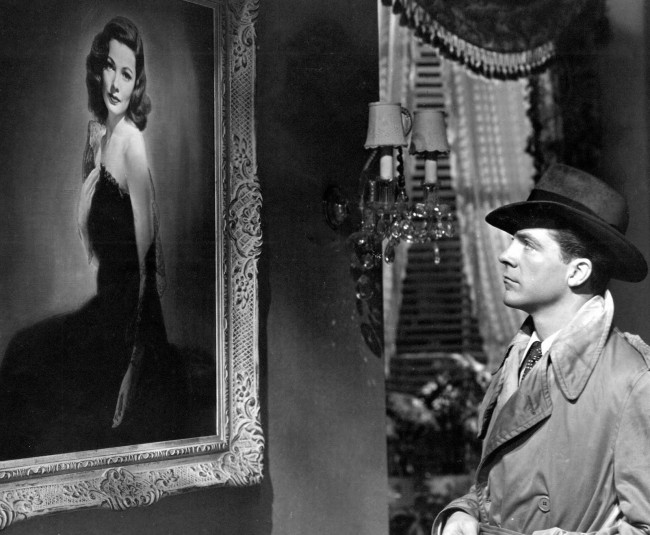During the 1940s and 50s, gifted directors together with Hollywood legends (Lauren Bacall, Barbara Stanwyck, William Holden, Humphrey Bogart) crafted stylish crime dramas combining the following elements:
– a deceitful, manipulative, double-crossing, but extremely beautiful and sexually appealing lady (a “Femme Fatale”);
– a cynical, and ethically compromised male main character, usually (but not necessarily) a private eye, or a detective;
– a visual style that emphasizes black-and-white photography, high-contrast lighting, distorted shadows, dark city streets, cigarette smoke, and fog.
The French critic Nino Frank coined the term “Film Noir” in 1946 to describe these films.
Norma Desmond (Gloria Swanson) dramatically descends her grand staircase and, proving she has completed her plunge into a delusional state of mind, delivers the film’s most famous line: “All right, Mr. DeMille, I’m ready for my close-up.” Sunset Boulevard (1950), one of the greatest films of American cinema, stands at the pinnacle of the “genre”. Franz Waxman composed a poetic, reflective and unforgettable score for the movie.
“Goodbye, Laura. Goodbye, my love.” Columnist Waldo Lydecker, police detective Mark McPherson, playboy Shelby Carpenter and every other man in the film will fall under the love spell (and eventually become obsessed with) the beautiful and highly successful advertising executive Laura Hunt (Gene Tierney), or with her notorious portrait. Composed over one weekend by David Raksin, the exceptionally sophisticated and haunting title theme song “Laura” will become one of the most recorded and performed songs of the 20th century (lyrics by Johnny Mercer). It clearly has become one of the film’s most endurable legacies. Both Laura (1944) and Sunset Boulevard (above) were honored in 2005 as two of the top 25 film scores in the American Film Institute’s “100 Years of Film Scores” list.
“In Italy, for thirty years under the Borgias, they had warfare, terror, murder and bloodshed, but they produced Michelangelo, Leonardo da Vinci and the Renaissance. In Switzerland, they had brotherly love, they had five hundred years of democracy and peace – and what did that produce? The cuckoo clock.” (Written by Orson Welles to be delivered by his character Harry Lime). The Theme from The Third Man (1949) is simply brilliant, full of suspense, shadowy betrayal, and postwar fear. Anton Karas wrote and performed the score using only the zither (a string musical instrument). It was no cuckoo clock; it easily topped most international music charts in 1950.
“The Fault… is Not in Our Stars, But in Ourselves…” (William Shakespeare).
Dr. Constance Petersen (Ingrid Bergman) is a psychoanalyst at a mental hospital in Vermont. She protects the identity of an amnesiac patient accused of murder. Miklós Rózsa bejeweled the famous dream sequence (designed by Salvador Dalí) of the film Spellbound (1945) with one of the most moving, thrilling, passionate and beautifully paranoid orchestral scores ever composed. Although the score won the Academy Award, Alfred Hitchcock didn’t like the music because “it got in the way of his direction” (quote from Rózsa).
Finally, I would like to highlight the scores from two late film noirs: Sweet Smell of Success (1957), and Touch of Evil (1958). Elmer Bernstein and Henry Mancini, two young and upcoming composers at the time, crafted these works of genius. Bernstein’s furious jazz and orchestral score done in collaboration with the Chico Hamilton Quintet is one of the top film music masterpieces in the 1950s. Mancini’s crime jazz score is sinister, sleazy, swinging, and very cool.
Notable Film Noir Scores
The Letter (1940)- Max Steiner
Rebecca (1940) – Franz Waxman
The Maltese Falcon (1941) – Adolph Deutsch
High Sierra (1941) – Adolph Deutsch
Laura (1944) – David Raksin
Double Indemnity (1944) – Miklós Rózsa
Spellbound (1945) – Miklós Rózsa
The Lost Weekend – (1945) – Miklós Rózsa
Mildred Pierce (1945) – Max Steiner
The Big Sleep (1946) – Max Steiner
The Killers (1946) – Miklós Rózsa
The Postman Always Rings Twice (1946) – George Bassman
Dark Passage (1947) – Franz Waxman
Brute Force (1947) -Miklós Rózsa
Force of Evil (1948) – David Raksin
Key Largo (1948) – Max Steiner
The Third Man (1949) – Anton Karas
White Heat (1949) – Max Steiner
Sunset Boulevard (1950) – Franz Waxman
The Asphalt Jungle (1950) – Miklós Rózsa
D.O.A (1950) – Dimitri Tiomkin
Strangers On A Train – (1951) – Dimitri Tiomkin
Suddenly (1954) – David Raksin
The Night Of The Hunter (1955) – Walter Schumann
Kiss Me Deadly (1955) – Frank DeVol
The Killing (1956) – Gerald Fried
Sweet Smell of Success (1957) – Elmer Bernstein
Touch of Evil (1958) – Henry Mancini

